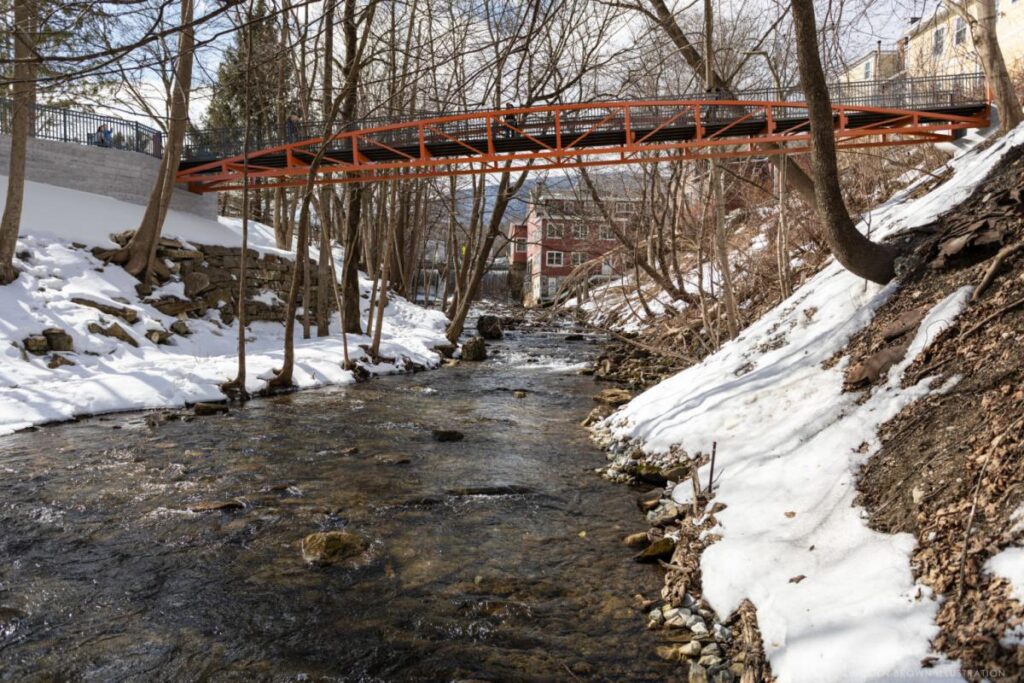Photo courtesy of Manchester Riverwalk
The bridge will be 110 ft. long, 8 ft. wide, sit approximately 20 ft. above the water and provide a dramatic view of the Mill Pond waterfall.
The Manchester Riverwalk Association in Vermont has started plans to construct a pedestrian bridge over the west branch of the Battenkill River, connecting Depot Street and Main Street in downtown Manchester.
The new, 110-ft.-long, 8-ft.-wide structure will make the town more accessible to pedestrians and bikers, association leaders told the Manchester Journal.
“We’re currently getting quotes for some of the final details like the cost of micro piles that we have to put in to hold up the abutments and site bearings,” said Margaret Donovan, the group’s president.
Once the association’s design review board approves the quotes, which is expected to happen in late October, construction will immediately begin with the abutments that connect the bridge to the steep bank above the river. After a winter break, the remaining work will occur next spring when the bridge will be assembled in two separate parts and placed on the abutments.
The new pedestrian bridge, projected to cost about $800,000, is designed to sit approximately 20 ft. above the water and provide a dramatic view of the nearby Mill Pond waterfall.
In addition to that, according to its proponents, the structure will:
- Offer a unique vantage point from which to see the river, join the Depot Street neighborhood to Main Street and create a compelling reason to explore Manchester.
- Provide access to everyone to enjoy the wonders of the Battenkill River. For example, it will include ADA access for those not able to scramble down to the river’s edge and offer a window into the entire river corridor.
- Bring increased attention to and education about the West Branch of the Battenkill and its critical trout population.
- Become the centerpiece of the Manchester Riverwalk trail system.
Volunteers Worked to Raise Money for Bridge
The idea for the Riverwalk was hatched in 2013 when community members came together to discuss ways to improve Manchester, the Journal noted, with the riverwalk bridge listed as one of four potential ideas labeled “high priority.”
Although beginning as just a small, informal committee of local citizens, Manchester Riverwalk Association’s members soon realized that it needed more structure to pursue fundraising events and grants, and over the years the group has grown to include about two dozen people.
Those efforts finally got under way in 2019 to make the pedestrian bridge a reality. Although COVID-19 created some obstacles to getting the necessary funding, the volunteer group has continued to raise money for the project over the last five years and has received donations of both time and money from the Bank of Bennington, the Right Track Foundation, and others.
Recently, Donovan said the association received a $400,000 grant from the Vermont Outdoor Recreation Economic Collaborative (VOREC).
“We’re immensely grateful for VOREC. That was an immensely generous grant,” she added.
Her colleague on the association board, Eileen Braheney, noted, “This is what allowed [the Riverwalk committee] to start construction.”
The monies already raised have paid for all the preliminary work leading up to building the bridge, as well as the structure’s design and engineering specs.
Once the pedestrian bridge is completed, the town of Manchester will take over its maintenance, according to the association.
In conversation with the Journal, Donovan and Braheney explained that the Manchester Riverwalk was not built simply to connect the community but to make it more accessible by providing a key link that joins the Town Green with Old Main Street. Additionally, connecting the two thoroughfares would help make downtown Manchester more ADA-compliant.
With the new bridge, they said, everyone will be able to enjoy the river from above without having to circumvent the roundabout.
Helping People Enjoy Manchester’s ‘Storied River’
On its website, the Manchester Riverwalk Association described the Battenkill as “a storied river” that led to the town being founded on its banks in the 1760s.
It also was key in making the southern Vermont community a favorite retreat from the cities. Today, the river “is crucial to our town’s history, to our current role as a tourist destination, and in building a more vibrant community.”
The association also noted, though, that many Manchester businesses face away from the Battenkill, access to the river is difficult, and for years the riparian zone was neglected.
Manchester Riverwalk began addressing those issues at the riverside, it said, adding “there is more opportunity to educate, inform and impress people with an amazing view from the bridge. Working together with the Manchester Historical Society, we will add information panels with historical photos and information about the views from the bridge, what they once encompassed, and how and why the landscape has changed.”
The group noted that similar riverwalks in other areas of New England have contributed significantly to helping their communities thrive, including pathways in Winooski and Middlebury in Vermont, and Great Barrington, Mass.
“Expand that concept by adding a pedestrian bridge over the waterway, and everyone is given the opportunity to more closely experience the river, [such as] school groups and seniors … bird watchers and fish fanatics, the disabled, and the parent pushing a stroller,” the Manchester Riverwalk Association said.
Read the full article here

